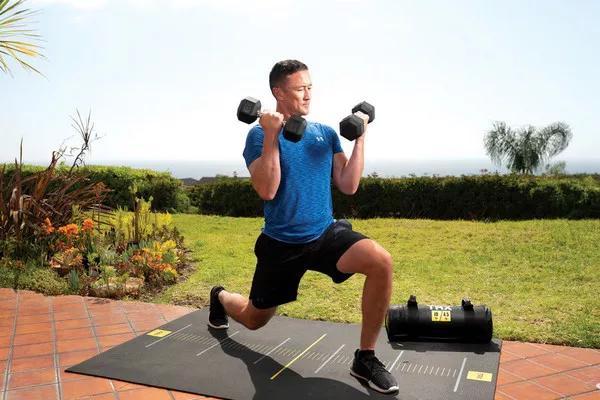Aerobic exercise is an effective way to lose weight and improve overall health. It is a type of exercise that increases heart rate and breathing, and can include activities such as running, cycling, or swimming. In this article, we will explore how much aerobic exercise you should do to lose weight and achieve your fitness goals.
What is Aerobic Exercise?
Aerobic exercise, also known as cardio exercise, is any type of exercise that increases heart rate and breathing. It is a great way to improve cardiovascular health, build endurance, and burn calories. Examples of aerobic exercise include running, cycling, swimming, dancing, and walking.
Aerobic exercise is different from strength training, which focuses on building muscle and strength. While strength training is important for overall health, aerobic exercise is essential for weight loss and improving cardiovascular health.
How does Aerobic Exercise Help with Weight Loss?
Aerobic exercise is one of the most effective ways to lose weight. It burns calories and increases metabolism, which can help to reduce body fat and improve overall body composition. In addition, aerobic exercise can help to reduce appetite and increase feelings of fullness, which can lead to a reduction in calorie intake.
How much Aerobic Exercise Should I do to Lose Weight?
The amount of aerobic exercise you should do to lose weight depends on a number of factors, including your current fitness level, weight loss goals, and overall health. However, the American Heart Association recommends that adults get at least 150 minutes of moderate-intensity aerobic exercise or 75 minutes of vigorous-intensity aerobic exercise per week.
Moderate-intensity aerobic exercise includes activities such as brisk walking, cycling, or swimming, while vigorous-intensity aerobic exercise includes activities such as running, high-intensity interval training (HIIT), or jumping rope.
It is important to note that these recommendations are for general health and fitness, and may not be sufficient for weight loss. To achieve weight loss goals, it may be necessary to increase the amount of aerobic exercise and incorporate other lifestyle changes, such as a healthy diet and strength training.
Tips for Getting Started with Aerobic Exercise
If you are new to aerobic exercise, here are some tips to help you get started:
Start slow: If you are new to aerobic exercise, start slow and gradually increase the intensity and duration of your workouts.
Find an activity you enjoy: Choose an aerobic exercise that you enjoy, such as dancing, cycling, or swimming. This will make it easier to stick to your workout routine.
Mix it up: Incorporate a variety of aerobic exercises into your routine to keep things interesting and challenge your body.
Set realistic goals: Set realistic goals for your weight loss and fitness journey, and track your progress along the way.
Get support: Join a fitness class or find a workout buddy to help keep you motivated and accountable.
Stay hydrated: Drink plenty of water before, during, and after your workouts to stay hydrated and prevent dehydration.
Warm up and cool down: Be sure to warm up with some gentle stretches and movements before your workout, and cool down with some gentle stretches and movements after your workout.
How to Determine the Right Amount of Aerobic Exercise for Weight Loss
While the American Heart Association’s recommendations for aerobic exercise are a good starting point, they may not be sufficient for weight loss. To determine the right amount of aerobic exercise for weight loss, you will need to consider a few factors:
Your current fitness level: If you are new to exercise, you may need to start with less than the recommended amount and gradually increase it over time.
Your weight loss goals: If you have a significant amount of weight to lose, you may need to increase the amount of aerobic exercise you do each week.
Your overall health: If you have any health conditions or concerns, you should consult with a healthcare professional before starting an exercise program.
Your schedule: Consider your schedule and how much time you can realistically devote to aerobic exercise each week.
Once you have considered these factors, you can create a plan for how much aerobic exercise to do each week. It is important to start slowly and gradually increase the amount of exercise over time to avoid injury and burnout.
Incorporating Strength Training with Aerobic Exercise for Weight Loss
While aerobic exercise is important for weight loss, it is not the only type of exercise you should do. Strength training is also essential for building muscle and increasing metabolism, which can help to burn more calories and improve body composition.
To incorporate strength training with aerobic exercise, you can do a combination of both types of exercise each week. Aim to do strength training exercises at least two days per week, and focus on exercises that target all major muscle groups.
Examples of strength training exercises include push-ups, squats, lunges, and bicep curls. You can use free weights, resistance bands, or bodyweight exercises to do strength training.
Conclusion
Aerobic exercise is a great way to lose weight and improve overall health. To achieve weight loss goals, it is important to incorporate aerobic exercise into your routine and make other lifestyle changes, such as a healthy diet and strength training. Follow these tips to get started with aerobic exercise and achieve your weight loss and fitness goals. Remember to start slowly, set realistic goals, and stay motivated and consistent with your exercise routine.
[inline_related_posts title=”You Might Be Interested In” title_align=”left” style=”list” number=”6″ align=”none” ids=”4533,4449,4386″ by=”categories” orderby=”rand” order=”DESC” hide_thumb=”no” thumb_right=”no” views=”no” date=”yes” grid_columns=”2″ post_type=”” tax=””]


































